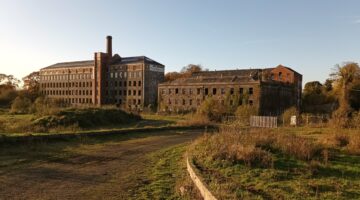Regular conservation and maintenance is the most effective way to protect historic buildings from decay. The most common cause of damage is from water getting in, either from roofs, rainwater goods or exterior walls. A regular scheme of inspection at a property can help to identify risk areas and put plans in place for repairs before damage occurs. Where a repair or restoration of historic fabric is necessary, it is good to employ the best of traditional building skills, the right materials and craftsmen to complete the work.
Maintenance Week NI 2018 will be from Friday 16th – Friday 23rd November. During that week, UAH will be working to remind historic building owners of the value of minor repairs and maintenance in the care of your historic building. We will also be providing good tips for maintenance practice, conservation and traditional building skills. Our Maintain to Retain events provide direct, practical support to historic building owners.
Maintenance Week is set annually for November, late Autumn, as this is a good time to think about maintenance as the leaves have fallen, gutters may be full, and it is a good idea to get all maintenance complete before Winter weather sets in. Early intervention and timely repair can save historic fabric and cost in the long term. However, you don’t have to wait until Maintenance Week to find out more about how best to look after your historic building. This, the maintenance section of the UAH website is designed to get you started, whatever the time of year.
REGULAR MAINTENANCE CHECKS
A basic list:
Exterior
- Roofs – check for slipped, cracked or missing slates and ridge tiles, decayed flashings and dislodged chimney pots and copings.
- Rainwater disposal – check for holes in, and misalignment of, gutters and downpipes; and evidence of blockages, including drains.
- Walls – watch for new bulging or cracking of masonry; deterioration of brick or stone surfaces; cracking or detachment of render; excessive erosion of mortar joints; and control the spread of plant growth into, or at the base of, walls.
- Joinery and paintwork – check for flaking paint and cracking timber to doors, windows, bargeboards etc.
- Windows – look for damage to panes, and for cracked putty.
Interior
- Roofspace – look for evidence of water penetration.
- Walls and ceilings – check plaster for damp or deteriorating patches and for the efflorescence of salts. These may indicate damp problems requiring investigation.
- Timbers and joinery – look for evidence of fungal growth on, or connected with, timber. A mouldy smell may indicate decay, as in some circumstances may springy timber floors. As fungal attack is most likely in dark, poorly ventilated areas, check cupboards and under stair areas, etc. Also, look for evidence of new beetle attack such as frass: adult beetles usually emerge from timber between May and August.
- Pipework – check water and heating pipes (particularly in areas not normally seen) for evidence of leaking joints.
The following links offer more detailed general conservation and maintenance advice as well as technical information and links. There are 13 sections in total which provide specific advice on traditional building specialisms and elements, such as joinery, ironmongery, roofs and glazing.
You may also like visit our Case Studies section for details of individual heritage buildings and projects. If you are seeking a craftsman or heritage professional to help with a project visit the Directory of Traditional Building Skills for a selection of those working in historic building conservation.
Find out more about maintaining your historic building:
- Download the Maintain to Retain Owners Guide
- How to look after your historic building?
- 1) Masonry – Stone & Brick
- 2) Roofing – Slating, Tiling & Thatch
- 3) Roofing – Leadwork & Copper
- 4) Ironmongery & Metalwork
- 5) Joinery
- 6) Plasterwork and Renders
- 7) Glass and Glazing
- 8) Tiles and Tiling
- 9) Paintwork
- 10) Fittings
- 11) Remedial Works
- 12) Services
- 13) Specialist Surveys & Photography
- 14) Funding
- Case Studies
- Directory of Traditional Building Skills
- Guide to Abbreviations Used

